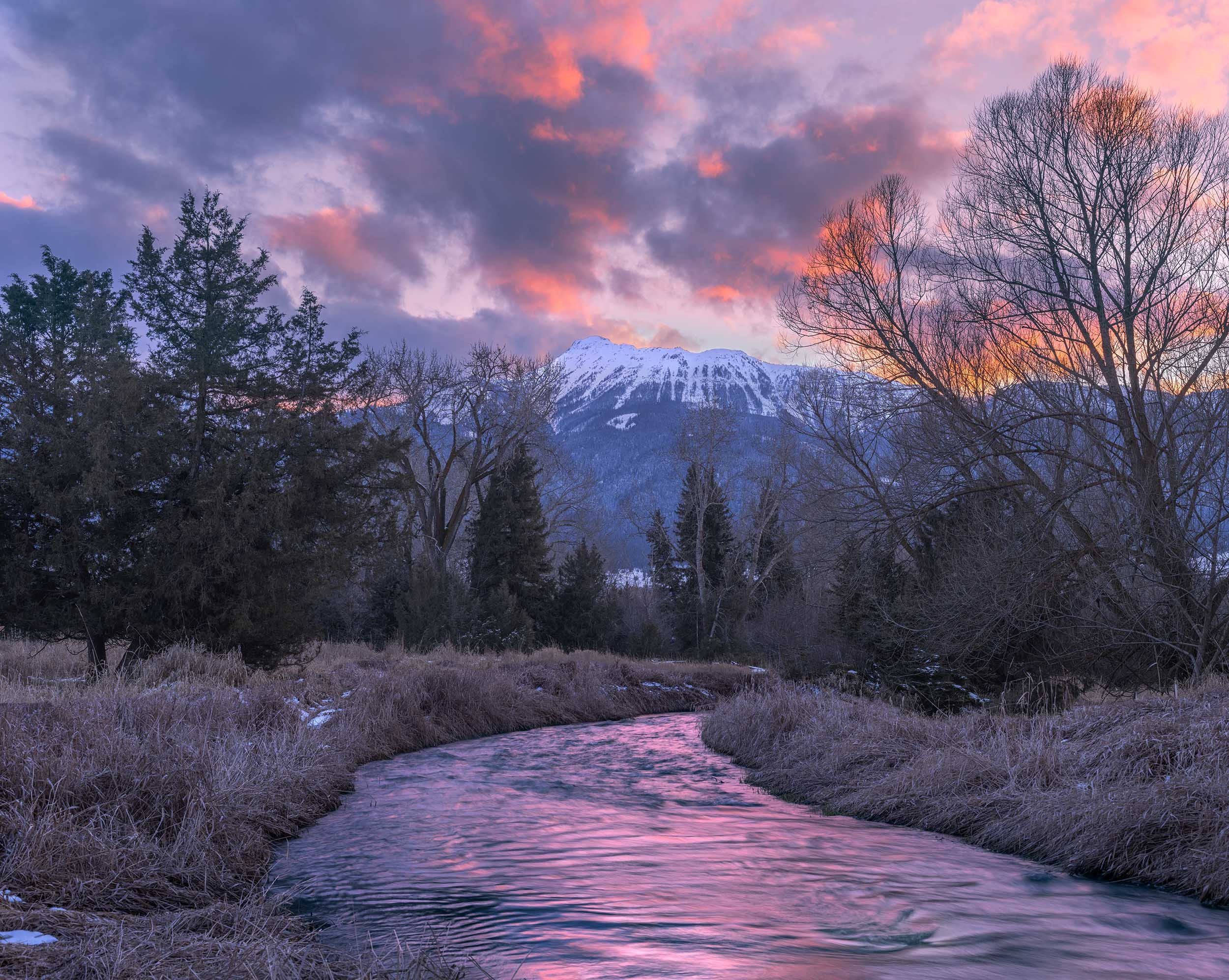WALLOWA VALLEY PHOTOGRAPHS
For more pages of Wallowa Valley photos, click Portfolios.
Photographically, the Wallowa Valley is a subject worthy of many portfolios. So far, there are four collections like this one, and more are on the way.
Over 4,000 feet above sea level at its upper end, the valley is abruptly flanked by the snowy Wallowa Mountains to the south and west which soar impressively well over five thousand feet above the valley floor. To the east, the craggy summits of Idaho’s Seven Devils Mountains can be seen prominently above Hells Canyon. Lacking a traffic light even in its biggest town, the valley nowhere could be described as urban even today more than a century and a half after agriculture-based civilization’s campaign to improve and manage the place. With sometimes no effort at all, you can still take photos here of a “natural” landscape.
The first surveyor who entered the valley in 1866, W. H. Odell, gushed with enthusiasm in explaining why in his opinion white men should not allow mere Indians to have this wonderful valley: “This line passes through the beautiful Wallowa Valley…Narrow streams of clear cold water put down from the high snow mountains just to the south. Timber is to the south and west and along the banks of the streams…The finest trout and salmon abound in the streams, and the surrounding mountains give evidence of plenty of game…Here I found many Indians camped on the banks of the streams, taking great quantities of fish, while their large herds of horses quietly grazed upon luxuriant grass…This valley should be surveyed as soon as practicable, for the wigwam of the savage will soon give way to the white man. Instead of the hunting and fishing grounds of the red men, the valley will teem with a thriving and a busy population.”
Or consider this description from H. R. Findley, a son of one of the earliest settler families who wrote fondly about his parents’ arrival in the Wallowa Valley: “Grand evergreen clad mountains crowned with snow capped peaks towered like mighty sentinels guarding the valley on the south and southwest…while on the east were miles and miles of bunch grass covered hills and valleys which ran on and on in undulating waves. It seemed to them that they had reached the end of their rainbow trail, the trail they had followed all the way from St. Joseph, Missouri…and here they were looking at their promised land.”
Since its “settlement” by palefaces in the 1870s, the valley’s remoteness has so far protected it from the teeming hordes envisioned by the surveyor. After a minor boom in the early 1900s, the valley’s population stabilized for nearly a century at, or not far under, 7,000 people. You can still do landscape photography here. You don’t have to drive a hundred miles or more to a national park or to some other isolated and tenuously protected and beleaguered set-aside where the vistas have not yet been totally transmogrified by the heavy hand of human ambition. But in recent years, the population in the valley has begun increasing. Will the surveyor be right in the end? Will the valley acquire its first traffic light? How ugly will things get? In these galleries can be found a vision, only somewhat phony, of what the place still looks like for discriminating photographers guided by preferences about what looks good in a landscape. You can still find scenes here that look good, landscapes with appeal.
B100 Wallowa Valley cattails below Ruby Peak
B101 Twin Peaks in clouds
B102 Twin Peaks and aspens
B103 Chief Joseph Mountain
B104 Twin Peaks and cottonwoods
B105 Prairie Creek
B106 Wallowa Valley double rainbow
B107 Lightning strike, Wallowa Mountains
B108 Willow along Wallowa River
B108 Prairie Creek
B109 Trout Creek vista
B110 Trout Creek Valley
B111 Chief Joseph Mountain
B112 Prairie Creek Clearing
B113 Enterprise Wildlife Refuge
B114 Ruby Peak
B115 Prairie Creek
B116 Prairie Creek
B117 Trout Creek
B118 Prairie Creek
B119 Prairie Creek
B120 Cattails below Ruby Peak
B121 Cloud layers, Wallowa Mountains
B122 Trees in fog
B123 Ruby Peak
Cattails and Ruby Peak
B125 Ruby Peak and cattails
B126 Frosted ponderosa, Wallowa Valley
B127 First light on Twin Peaks
B128 Field of summer, Wallowa Valley
B129 Chief Joseph Mountains
B130 Mt. Bonneville
B131 Upper Wallowa Valley
B132 Moon over Wallowa Mountains
B133 Sawtooth Peak
B134 Wallowa Valley
B135 Wallowa Valley
B136 Enterprise Wildlife Area
B137 Wallowa Valley below Wallowa Mountains
B138 Winter in Wallowa Valley
B139 Wallowa Valley barn
B140 Prairie Creek at sunrise
B141 Canola, Wallowa Valley
B142 Wallowa Valley barn
B143 Frost, Wallowa Valley
B144 Balsam Root blooms, Wallowa Mountains
B145 Wallowa Valley
B146 Prairie Creek, Wallowa Valley
B147 Wallowa Valley
B148 Prairie Creek, Wallowa Valley
B149 Wallowa Valley
B198 Barn, Wallowa Valley
B199 Road to Ant Flat
B200 Frosted Wallowa Valley
B150 Wallowa River
B151 Prairie Creek
B152 Cottonwoods below Twin Peaks
B153 Twin Peaks above cottonwoods
B154 Enterprise Wildlife Area
B155 Enterprise Wildlife Area
B156 Enterprise Wildlife Area
B157 Enterprise Wildlife Area
B158
B159 Wallowa Valley
B160 Wallowa Valley
B161 Chesnimnus Country and Wallowa Mountains
B162 Wallowa Lake
B163 Mountain in clouds from Wallowa Valley
B164 North Hurwal Peak
165 Trout Creek
B166 Trout Creek Valley
B167 Trout Creek
B168 Trout Creek
B169 Trout Creek
B170 Trout Creek
B171 Prairie Creek
B172 Prairie Creek
B173 Prairie Creek
B174 Praire Creek
B175 Ruby Peak
B176 Enterprise Wildlife Area and Wallowa Mountains
B177 Trout Creek
B178 Mountains in clouds
B179 Ruby Peak
B180 Wallowa Valley
B180 Lightning, double rainbow, Wallowa Valley
B190 Wallowa Valley
B191 Frosted ponderosa, Wallowa Valley
B192 Frosted ponderosa, Iwetemlaykin
B193 Frosted ponderosa
B194 Wallowa Valley
B195 Prairie Creek
B196 Prairie Creek
B197 Enterprise Wildlife Area





























































































